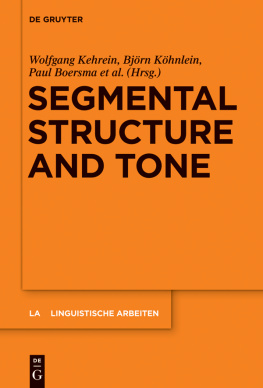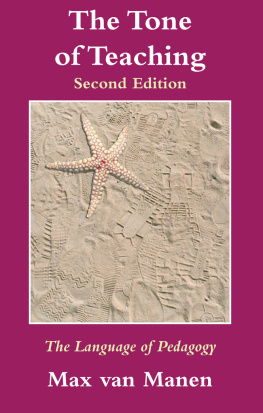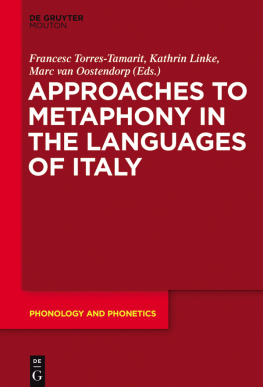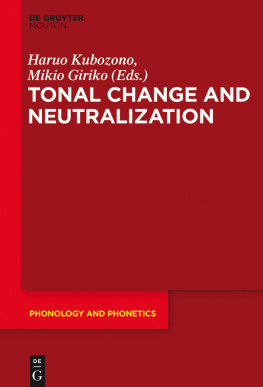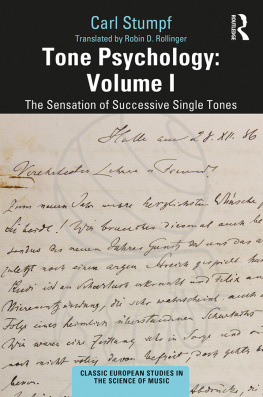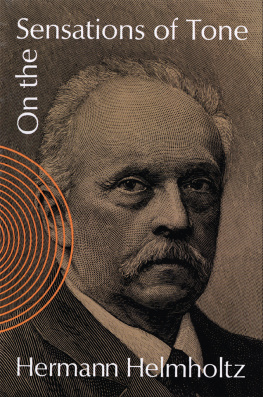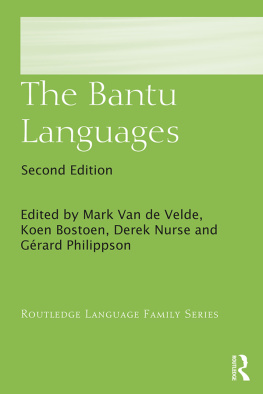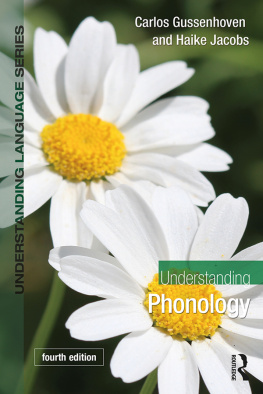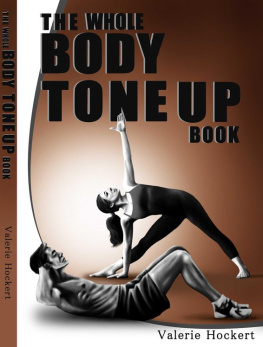Contents
Guide

Segmental Structure and Tone
Linguistische Arbeiten

Edited by
Klaus von Heusinger, Gereon Mller,
Ingo Plag, Beatrice Primus,
Elisabeth Stark and Richard Wiese
Volume 552

ISBN 978-3-11-034109-6
e-ISBN (PDF) 978-3-11-034126-3
e-ISBN (EPUB) 978-3-11-037749-1
ISSN 0344-6727
Library of Congress Cataloging-in-Publication Data
A CIP catalog record for this book has been applied for at the Library of Congress.
Bibliographic information published by the Deutsche Nationalbibliothek
The Deutsche Nationalbibliothek lists this publication in the Deutsche Nationalbibliografie; detailed bibliographic data are available on the Internet at http://dnb.dnb.de.
2018 Walter de Gruyter GmbH, Berlin/Boston
www.degruyter.com
Bjrn Khnlein, Marc van Oostendorp
Introduction
Bjrn Khnlein, The Ohio State University,
Marc van Oostendorp, Meertens Institute,
Tonal and segmental phonology are core areas in the study of sound patterns. Roughly, segmental phonology deals with phenomena that affect the pronunciation of vowels and consonants. Tonal phonology, on the other hand, investigates the use of fundamental frequency for linguistic purposes, at the lexical level (protoypically tone languages, such as Mandarin) or at the post-lexical level (prototypically intonation languages, such as Dutch or German). Particularly after the rise of autosegmental phonology (Leben 1973, Goldsmith 1976), many similarities between tone and segmental structure have been uncovered: for instance, both tones and segmental features spread, and both interact with metrical structure, such as with word stress, in similar ways. In most models of phonology, they therefore receive identical treatment. For instance, both are considered to be composed of features, possibly living in some feature-geometric arrangement on a set of autosegmental tiers.
Such a model makes a number of predictions, however, that do not always seem to be sufficiently verified. First, it predicts that tones and segmental features such as [Labial] or [Voiced] have a similar kind of behaviour. Secondly, it suggests that tonal features interact as freely with segmental features as the latter do among each others. These predictions seem to be partly true; but there are also certain problems.
This volume seeks to reevaluate the nature of tonesegment interactions in phonology. The contributions address, among other things, the following basic questions: what tonesegment interactions exist, and how can the facts be incorporated into a phonological account of the language? Is interaction between tones and vowel quality really universally absent? What types of toneconsonant interaction do we find across languages? What is the relation between diachrony and synchrony in relevant processes?
The papers in this volume deal with the relation between segmental features and tone from a variety of angles. There is an empirical emphasis on Franconian dialects in the Netherlands, Belgium and Germany, but other languages and language families are also discussed, such as Fouzhou (Chinese), Livonian (Finnic), Nguni (Bantu), and Slovenian (Slavic). It is shown how some of the predictions of the standard model seem more problematic, and solutions to some of these problems are also mentioned.
In this introduction, we briefly sketch some of the theoretical background: which of the predictions are verified? Which ones are problematic?
1Tones and segments: similar behaviour
Tones and segments sometimes behave in a similar way. Consider for example the influence of word stress on the distribution of tone and vowel quality. The interaction between vowel quality and stress is a driving factor in phonology. For instance, it has been repeatedly observed that vowels in stressed syllables tend to be more sonorous than those in unstressed syllables. In a nutshell, this means that the lower a (peripheral) vowel is, the likelier it is that this vowel will be stressed (Kenstowicz 1997, 2004; de Lacy 2006, 2007).
One example of sonority-driven stress can be found in Takia, a North New Guinea language: in the language, word stress falls on the syllable that contains the most sonorous vowel (Ross 2002, de Lacy 2007):
| (1) | Sonority-driven stress in Takia |
| a. | [i-saes] hawk [a-sol] 1sg-flee |
| b. | [kiren] her/his finger, toe [i-emi] your (pl.) legs/feet |
| c. | [ifuno] s/he hit you [mulmol] a kind of a tree |
(1a) demonstrates that in words containing a low and mid vowel, the low vowel will receive stress, as it is of higher sonority. Likewise, in (1b, c), the mid vowels are preferred over the high vowels. These facts can be expressed in a sonority scale; for purposes of illustration, the sonority scale for tense vowels is provided in (2). The higher a vowel is ranked in the sonority, the likelier it is that this vowel will be a potential stress-bearing unit.
| (2) | Sonority scale for tense vowels in descending order |
| a > e, o > i, u |
Crucially, interactions between prominence and stress are not restricted to segments but can also be found in the relation between tone and metrical structure. As de Lacy (2002) argues, the interaction between tone and stress is governed by a tonal prominence scale, comparable to that for vowels: high tones (H) and metrically strong positions attract each other, as do low tones (L) and metrically weak positions; mid tones (M) are located in between H and L. The resulting prominence scale, which closely resembles the sonority scale in (2), is provided in (3).
| (3) | Tonal prominence scale in descending order |
| H > M > L |
One relevant example comes from Ayutla, a Mixtec language where tonal prominence is relevant for determining the position of stress. For our purposes, it serves to state that stress is realized on a syllable carrying the most prominent tone in the word (the full pattern is somewhat more complex, see Pankratz & Pike 1967, de Lacy 2002 for discussion). In disyllabic words, stress is therefore on H, if the word contains a high tone (4a, b, c). In the absence of H, stress will fall on M (4d).
| (4) | Some stress patterns in Ayutla disyllabic words |
| a. | HL [n] hat |
| b. | LH [pl] brown sugar |
| c. | MH [[jakwa] it is crooked |
| d. | ML [nam] wall |
As these examples demonstrate, tone and vowel quality interact with metrical structure in a similar way. Metrically strong positions correspond to relatively prominent tones/vowels, and metrically weak positions correspond to less prominent tones/vowels.
2Non-interaction between segmental features and tone
Given that tonal features and the segmental features responsible for vowel height interact with the stress system in a similar way, one would expect them to also interact with each other. Interestingly, however, there seems to be much less clear-cut evidence for such interactions. In fact, it has even been assumed that direct interactions between tones and vowels are absent in the worlds languages. Consider the following universal that has been proposed in the literature:

